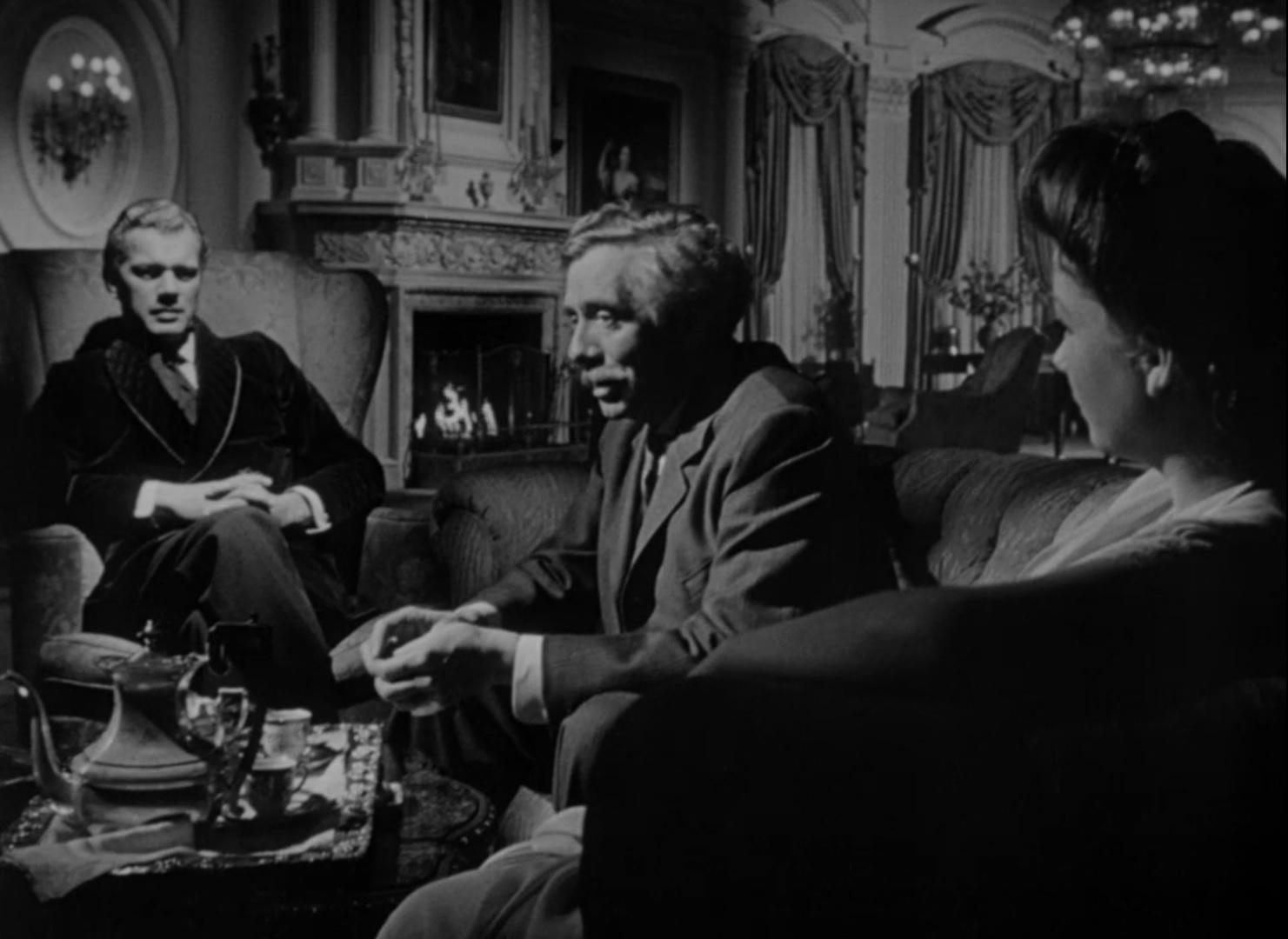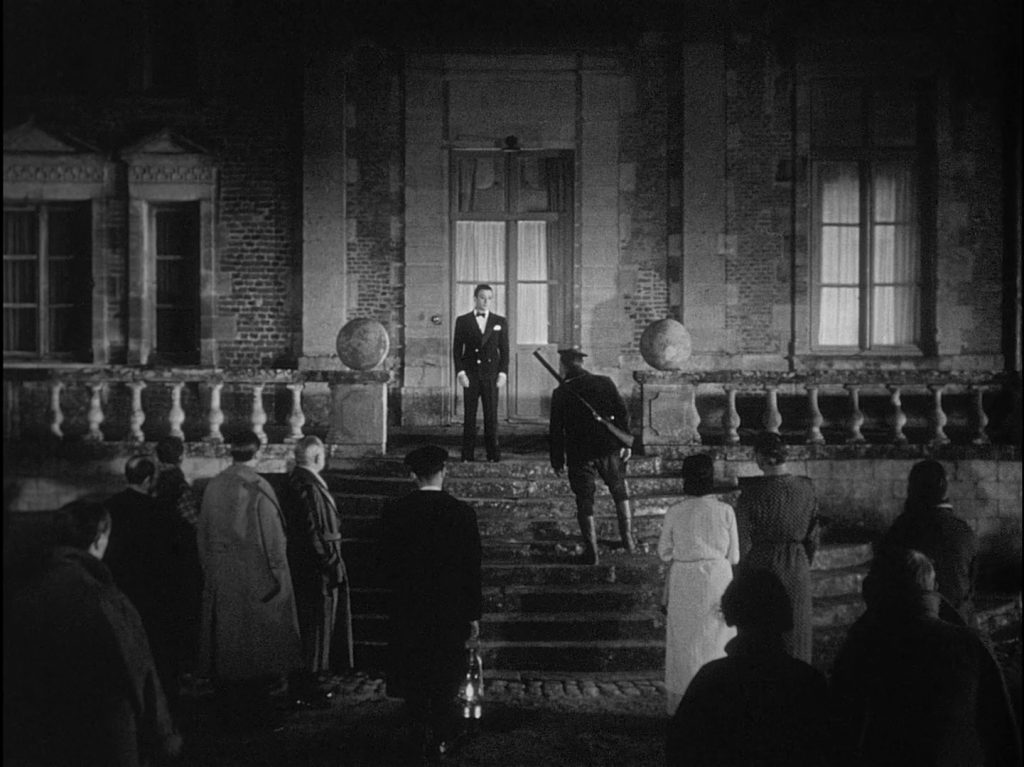By Dominic Lash
In his contribution to The Language and Style of Film Criticism (2011), Andrew Klevan discusses a description of Orson Welles’s The Magnificent Ambersons (1942) that was written by his former teacher, V.F. Perkins. For Klevan, Perkins’s description of the scene about two-thirds of the way through the film between Uncle Jack (Ray Collins), Eugene Morgan (Joseph Cotten), and Lucy Morgan (Anne Baxter) “draws out a series of apparently contradictory characteristics of presentation that trouble our sense of prominence” (Klevan 2011: 83). It “avoids,” for example, “the straightforward parallels that are sometimes made in criticism” such as the assumption that “the character furthest away is necessarily the least noticeable” (ibid.); the description makes it clear that this is certainly not the case here with regard to Eugene. In doing so, Perkins’s writing offers “an example of the descriptive critic working on behalf of the film, continuing its work… Description is not simply a matter of telling us accurately or evocatively what we can see, but what we may come to see” (ibid.).

In an article forthcoming in the New Review of Film and Television Studies entitled “V.F. Perkins and the redescription of films,” I interpret Klevan’s remark as indicating that description is important largely because of the constant possibility of redescription. If we can “come to see” things differently this must be because we have managed in some sense to redescribe them, leading to shifts in perspective and insight. I develop Klevan’s notion that a critic’s acts of description can be seen as continuing the work of the film, albeit in a direction that neither Perkins nor Klevan explicitly considered, namely the claim that films themselves engage in procedures of description and redescription. To describe can also mean to mark out or draw, as in the geometrical sense of the word. As a narrative film progresses it describes – in the sense of outlining and filling in – a whole range of persons, events, attitudes, and so forth. Resisting the kind of excessively sharp distinction between description and interpretation that he would later take David Bordwell to task over, Perkins wrote in his book Film as Film (originally published in 1972) that “descriptive analysis will need at the least to make claims about the distribution of the film’s emphasis” (Perkins 1993: 191). In distributing that emphasis by means of what Nicole Brenez refers to as “a passage between altered images” (Brenez 2007: 21), films perform the acts of selection and emphasis necessary for something that we can meaningfully call description to take place. Beyond this, my article also claims that Perkins offers particular insights into failures of redescription, which is to say into films that dramatize and investigate situations in which characters’ attempts to redescribe their situations – to come to see them differently – do not come off, whether spectacularly so or more subtly. I explore this chiefly with reference to Perkins’s work on Max Ophüls’s Letter from an Unknown Woman (1948) and Elia Kazan’s America, America (1963). But comparable phenomena are also at work, albeit more unobtrusively, in Perkins’s book on Renoir’s La Règle du jeu (The Rules of the Game, 1939), about which William Rothman has written that “surely, there is no greater book of film criticism” (Rothman 2020: 123). I want in the rest of this brief piece to offer some preliminary evidence that this is so.
A good place to start is with Perkins’s use of the word “gloss”. He used it when describing the conclusion to America, America, and he opts for it again when he writes of “the marquis’ behaviour under the most testing circumstances, when Robert has succeeded in putting an acceptable gloss on the slaughter of Jurieux” (Perkins 2012: 36). A gloss is, primarily, an interpretation (as in a gloss of a difficult text provided to students to assist their comprehension), but it also suggests a sheen (as in gloss paint), a superficial shininess that is not to be trusted. In glossing the death of André Jurieux (Roland Toutain) at the hands of the gamekeeper Schumacher (Gaston Modot) in a complicated case of mistaken identity, the Marquis de la Chesnaye (Marcel Dalio) has to redescribe the event – he cannot, of course, call it “slaughter”. Instead, from his “exposed position” on the steps of the chateau, he manages to find “both the necessary warmth in speaking of Jurieux and the necessary formality in offering an explanation of the ‘deplorable incident'” (ibid.: 36-37). At stake here is not merely the content of La Chesnaye’s description but the manner of its execution, clearly exhibited by the film’s mise-en-scène, which is both “elegantly shaped” (as Perkins writes of the marquis’s language; ibid.: 37) and expressive of exposure, of the risk the situation poses both to the marquis and to his audience; once again the “character furthest away” is far from “the least noticeable” (Klevan 2011: 83; see Fig 3). In this, the marquis’s performance at the film’s conclusion is unlike, for example, his earlier indecorous search for the ‘screw’ to his ‘warbler’ (see Fig 2), or his rather embarrassing lack of “gloss” when showing off his limonaire (a huge, automated fairground-style organ), at which point his enthusiasm almost gets the better of him. It is chiefly La Chesnaye’s manner in this, his final performance which leads “the bluff old general [Pierre Magnier] who serves as both the arbiter and the mourner of upper-class decorum” (Perkins 2012: 36) to respond negatively to his companion Saint-Aubin’s (Pierre Nay) dryly explicit declaration of the marquis’s redescription (‘A new definition of the word “accident”!’). In what is “practically the last line in the film” (ibid.), the general declares ‘no, no, La Chesnaye is not without class’. The general admires the performance because he, along with the rest of the marquis’s audience, has an interest in the successful redescription of the event. Without it, the audience would have had to confront (semi-publicly) some things that they would much rather not confront. The redescriptive failure here is moral; it is in the very fact that the redescription can be deemed to have been successfully achieved (even though nobody present truly believes in it) that this failure lies.


There is, then, a singular instance of redescriptive failure (failure by means of success) at the end of The Rules of the Game. Perkins points out that Renoir’s film also begins with a failed redescription. Jurieux, an aviator, lands in Paris after crossing the Atlantic, but is distraught to discover that the woman he loves – La Chesnaye’s wife Christine (Nora Gregor) – has not come to meet him. Perkins observes that “André seems to have turned back the clock on aviation to convert his solo flight into a knightly quest, performed to show him worthy of a lady’s favour” (ibid.: 28), but this conversion is undermined by Christine’s failure to meet him upon his return. The film describes a path from Jurieux’s failure to regulate the proprieties of public and private (he turns a public radio broadcast into a petulant private outburst aimed at Christine), to La Chesnaye’s success – highly dubious though it is – at regulating comparable proprieties after Jurieux’s death. This is not to suggest that the film is usefully seen as governed by this compromising movement towards successful redescription, as a kind of inverse to the failures of redescription which, my article argues, do govern the global structures of Letter from an Unknown Woman and America, America. There is far too much going on in the film for this to be the case. And yet, the great many attempts at redescription it contains – many (perhaps even most) of which do indeed come a cropper – are crucial parts of the film’s complexity. This, I suggest, is one reason why description gets harder and harder as the film progresses. Just when it seems to be becoming more clearly recognisable as a farce, its tonal, formal, and narrative shifts start to make it increasingly difficult for viewer and critic alike to subsume what is happening under familiarly accessible terms. As Perkins puts it, “Renoir arranges the drama so as to avoid narrowing the terms of our understanding. The surprises that he springs do not simply exchange one set of assumptions for another. Rather they produce a less and less easily defined complex of fact and possibility” (ibid.: 65). (It is because of this that Gilles Deleuze declares that, despite being “one of Renoir’s finest films”, The Rules of the Game “does not give us the key to the others” (Deleuze, Cinema 2: The Time-Image, trans. Hugh Tomlinson and Robert Galeta [London: Continuum, 2005], p. 83). Elsewhere in Renoir’s work, Deleuze claims, “[e]verything happens… as if roles were being tried out until the right one were found, the one with which we escape to enter a clarified reality” (ibid.). The discovery of such a role is conspicuous at the end of The Rules of the Game only by its absence; the reality offered by the film’s conclusion is clouded rather than clarified.)
How, for example, should we describe the “complex of fact and possibility” that is the state of the marriage between Christine and La Chesnaye at the end of the film? The fact that Christine is the only other person in the film to have been said by the general to have ‘class’ suggests that they are in some sense well-matched, at least according to the old order; and yet that order is evidently passing away, as is indicated by the shadows on the wall of the château with which the film ends. How much does the situation in which we leave Christine and La Chesnaye involve a recognition of reality and how much a resignation of possibility? (And on whose part, exactly?) Recall the maxim by Chamfort that Geneviève (Mila Parély) quotes early in the film: ‘Love as it exists in society is merely the mingling of two whims and the contact of two skins’. Despite the phrase’s surface gloss of easy cynicism, it is no easy matter to determine whether – as we may initially be inclined to think – it is now less relevant than ever or whether it is, instead, all the more pertinent to the situation in which we leave Christine and La Chesnaye. That The Rules of the Game manages, as it proceeds, cumulatively to complicate description – without ever resorting to mere obscurity – is one of its most remarkable achievements. Similarly, it is a great accomplishment of Perkins’s book that its use of description helps us to comprehend a great deal about how it is that the film does this without ever “narrowing the terms of our understanding”.
5th November 2021
Read Dominic Lash’s article “V.F. Perkins and the redescription of films” in New Review of Film and Television Studies.
Sign up for NRFTS alerts so you’ll know when future articles become available, and enjoy this related read:
E.M.S. Woods, “The influence of Henri Bergson on film criticism and theory”
Lourdes Esqueda Verano, “There is no such thing as one realism: systematising André Bazin’s film theory”
References
Andrew Klevan, “Description”, in Alex Clayton and Andrew Klevan, eds., The Language and Style of Film Criticism (London and New York: Routledge, 2011), pp. 70-86. The passage by Perkins to which Klevan is referring can be found in V.F. Perkins, The Magnificent Ambersons (London: BFI, 1999), pp. 63-65.
V.F. Perkins, Film as Film: Understanding and Judging Movies (New York: Da Capo, 1993)
Nicole Brenez, Abel Ferrara (Urbana and Chicago: University of Illinois Press, 2007)
William Rothman, “Film as Film and the Personal”, in David LaRocca, ed., The Thought of Stanley Cavell and Cinema (New York: Bloomsbury Academic, 2020), pp. 120-126.
V.F. Perkins, La Règle du Jeu (London: BFI, 2012). Perkins spells “Jurieux” as “Jurieu,” which I have silently altered to the former.
